- 197 Tests
- 3146 Questions
- One-off payment
Tips to Pass a Watson Glaser Critical Thinking Test
What is a Watson Glaser Critical Thinking Task?
A Watson Glaser test is used to evaluate the ability of a candidate to think critically. It usually helps to predict how you comprehend a given problem or a situation. The questions may have multiple perspectives that should be factored in while determining the solution to the given problem. You may have to analyze the problem from different viewpoints and arrive at a solution after evaluating the merits and demerits of the different choices at hand.
Watson Glaser tests help to determine the understanding, analyzing and decision-making capabilities of different individuals. They are usually timed, and the candidates are required to answer the given questions within the enforced time limits. Business organizations often use these tests for hiring employees for various managerial positions. Here you can find some example questions.
Check our Watson Glaser Preparation Package
Passing a Watson Glaser Test
The following tips and techniques are to help you ace the Watson Glaser critical thinking test:
- Answer Strictly as per the Given Information
Someone appearing for a Watson Glaser test conducted by an organization usually has a background from the domain associated with the job position or role they are interested in. They may also have numerous years of practical experience backing them if they are applying for a managerial job that requires you to have prior career accomplishments. In such a case, the candidate may be tempted to answer a given question utilizing their own knowledge and experience. This is ill-advised as the tests are usually used to measure the critical thinking ability and require answers to be based solely on given facts and conditions. The correct answer based on the candidate’s personal perception might be different from the answer that will be true for the context given in the problem. Therefore, only the information specified should be utilized while arriving at a solution.
- Recognize the Context of Question
The questions given in the Watson Glaser test may have multiple perspectives to look at them, and each of these perspectives may have a different correct answer. You need to understand the context of the question before concluding. You may interpret a question the wrong way and so may give an incorrect answer, which in your perspective might be the right one. Thorough reading and re-reading of the question and the passage may be helpful. Recognizing the context of the question before finding the answer may also help you approach the question’s passage directly from the correct perspective and look for information that can help you deduce the same.
- Read Carefully and Don’t Skip Sentences
Watson Glaser test questions usually come with long passages that you may think about skimming through, or you may even skip a few sentences here and there considering the shortage of time. While doing this, you may miss vital pieces of information in the passage that could be the deciding factor for answering the questions correctly. Every sentence and statement in the given question should be read carefully and no part should be skipped. The passage should be read multiple times before answering a question to get a thorough understanding and ensure that no data has been overlooked.
- Establish Logic between Statements
Answering the question in a Watson Glaser test usually requires factoring in the logical relationships between the statements in the given passage. Analyzing the statements that are interdependent or related and determining the nature of the logic between them, i.e., whether it holds or is fallacious helps in arriving at the correct conclusion. Prior knowledge of different logical fallacies that the questions may contain and adequate practice can help you identify if any false logic exists in between the statements of the passage.
- Look for Contradictory Sentences
There may be a sentence in the question that presents a fact or a logic from a given perspective, and there may be another statement contradicting the former. This counter statement may immediately follow the original sentence where the chances of it being misinterpreted by you are high; or it may be hidden somewhere else in the passage, in between more relevant data and so it may not be easily recognized. While answering the test, you should look for such statements that contradict each other and defy the logic. The whole answer to the question should be based on the presence of such statements and the logical relationship between them.
- Time Management and Pacing the Test
The questions in the Watson Glaser test are usually complex and the time required to answer each question or section may not be predicted. Some questions may take less time while others may take a while to solve. As every statement and word in the given passage plays a significant role in answering the question correctly, adequate time should be spent on them. The test questions should be answered at a generous pace, assigning each question its full quota of time without rushing through. Thorough knowledge of the number of sections and the number of questions in each section beforehand may help you divide the time appropriately among all the sections.
- Be Aware of Double Negative and Tricky Words
The statements in the question or the passage may use double negative or other tricky word combinations that might be difficult to decipher and confusing to interpret. Such statements should be read meticulously. A divide and conquer technique may be used to figure out such a statement. Moreover, the statement may be divided into multiple meaningful word segments, and then the change in the flow of the statement with the words can be figured out.
- Practice
Prior practice is an important part of the Watson Glaser test as it is for any other test. Regular practice helps you become acquainted with the format of the exam and the questions you might expect. It strengthens the ability of you to identify logics and analyze their validity. You may also recognize your areas of strengths and weaknesses, and improve upon the same. There are many practice tests to be found online.

How to prepare for a Watson Glaser Critical Thinking Test?
Practice with Online Resources
To be honest and fair, the Watson-Glaser test is famed to be unique, and a tough-nut-to-crack. It requires the highest capability of reasoning skills, and to improve one’s critical thinking sounds like a goal to set, but in reality, it is challenging to discipline your thoughts. In that perspective, we suggest that you do it old school, with a lot of practice.
Assessment-Training.com offers an extensive Watson Glaser Preparation Package that will get you ready for your Critical Thinking test!
It is to be kept in mind that you are practising to learn, not just to pass the test. Almost all of the test takers keep the passing percentage confidential, rendering it no matter, so focus on what really does matter, i.e., getting better at critical thinking.
You can also check Critical Thinking Skills: Developing Effective Analysis and Argument (Palgrave Study Skills)
Cover the basic RED Model of Critical Thinking
There is a thought process model that can be used to develop self-awareness. With the identification of thought patterns and understanding one’s biases, one builds on thought process with the help of the Pearson RED critical thinking model. Every candidate needs to know everything there is to know about the RED Model as it lists;
Recognize Assumptions from the extensive set of material that are justifiable, and logical.
Evaluate arguments based on the strengths and weaknesses, for underlying assumptions.
Draw conclusions carefully after considering all the basic underlying facts, and do think about the consequences of conclusions.
Improve Critical Thinking
Watson-Glaser tests challenge a candidate’s critical thinking ability. Critical thinking as defined by The Foundation for Critical Thinking says;
“Critical thinking is the intellectually disciplined process of actively and skillfully conceptualizing, applying, analyzing, synthesizing, and/or evaluating information gathered from, or generated by, observation, experience, reflection, reasoning, or communication, as a guide to belief and action.”
Critical thinking ability comes from;
a) Conceptualization of one’s idea
b) Analysis based on the conceptualization
c) Synthesizing the justification for ideas and their conceptualization
d) Evaluation of the justification, whether they are accurate or have been formed on a misguided notion.
This thought process generates observation, experience, reflection, reasoning, and communication. All of these steps lead to a place, where a person forms his beliefs and act on them.
Critical thinking comes from the roots of everyday activities, and with the improvement in the learning curve, one’s critical thinking improves. Critical thinking may not be as strong for a candidate, as it is for another one, but it can be improved by employing a basic strategy by;
a) Go to the basics
While taking the practice test, ask the most basic questions that are out there, because sometimes a situation needs to be understood, from its origin. Some of the most basic questions that come along are; what, why, and how.
b) Reevaluate assumptions
While taking a practice test, it is advised that you question, even the most basic assumptions to understand better. As said by Isaac Asimov; “Your assumptions are your windows on the world. Scrub them off every once in a while, or the light won't come in.”
c) Master your thought process.
As Albert Einstein said;
"The world as we have created it is a process of our thinking. It cannot be changed without changing our thinking."
The human mind uses a heuristic approach and arrives at the most obvious conclusion, whereas one, who has mastered his thought process, has the ability to make unbiased assumptions and go further, drawing more accurate conclusions. So, while taking a test, never take the easy route and never accept the most obvious answer.
d) Go back to the basics now and then and reverse them
One of the most basic evaluation tactics is to try reversing things. The pursuit of reverse knowledge has been used widely and is believed to give way to sound judgments. So use the reverse strategy, whenever you feel confused and hesitant.
Watson-Glaser Critical Thinking Appraisal (WGCTA) is used in the induction process because it works, and because it predicts how a candidate will perform in a corporate environment, over a period of time, makes it much more reliable.
So if you want to work in a highly competitive market, be prepared. Practice more and make sure you come prepared for your critical thinking test!

Purpose of Watson Glaser Critical Thinking Test
Watson-Glaser Critical thinking test has been designed to evaluate the ability of a person to absorb information, understand its significance, and assess situations based on information provided at the time. The universe is designed around the idea of diversification, in each aspect of life. Critical thinking refers to the ability of a person to consider this diverse information rationally and devise a logical view. A true critical thinker does not simply accept someone else’s conclusions and arguments but seeks his own truth. With a clear sense of self, he makes connections, judges the quality of information, and analyzes the authenticity of the arguments presented.
A human mind is a complicated machine, and with the values of family and everything around a person’s life, he has to have a biased opinion and beliefs. The practice of critically evaluating one’s arguments separates opinions from facts and helps him get a clear understanding of the situation.
Foundation of Watson-Glaser Critical Thinking Test
Watson-Glaser critical thinking test has been developed on the foundation of Pearson’s RED critical thinking model, which lists the skills that are needed in critical thinking and how to develop them. The RED represents:
R- Recognize Assumptions
E- Evaluate Arguments
D- Draw Conclusions
Recognize Assumptions
It is simply separating facts from opinions. To recognize assumptions means, that a person has to view the information critically, in light of the assumptions made. This practice can be compared to separating the wheat from the chaff. The main purpose is to understand whether the information is correct or not, by uncovering the information gaps and unfounded reasons. By examining an assumption from different angles results in a richer perspective. It is advised to make sure that the fact isn’t actually an opinion in disguise.
Evaluate Arguments
In life, most of the information is tainted because people hear, what they want to hear. But to evaluate arguments is to set aside emotions, and sift through the conflicting information, objectively. People process information more accurately when they take an unbiased stand and question the underlying arguments better.
Draw Conclusions
The possession of this skill particularly refers that a person has the ability to draw conclusions based on the information underlined, supported by evidence, and is classified as “good judgment”. To draw a conclusion refers to the logical result achieved by bringing together diverse information together and selecting an optimal course of action.
Areas of testing
There are five basic areas of testing for the Watson-Glaser Critical Thinking Test;
- inferences
- assumptions
- deduction
- interpretations
- evaluation of arguments.
Every applicant has to answer questions that are logically justified for any of these areas, with the given information.
The test narrates a passage, and then a statement is given. The candidate has to pass the critical assessment of the statement that how true it is, relative to the passage narrated along with it.
Recognizing Assumptions
The assumptions are the underlying facts that many people fail to acknowledge. In such questions, the candidates are presented with a statement. Then the statement is followed by several assumptions and the candidate has to assess whether the assumptions have been made or not.
When you say, “I will buy iPhone X next week.” You actually do not consider the underlying fact, whether you will be alive, or the payment, which is scheduled to arrive, maybe held under any pretence.
Therefore, the far granted and presupposed assumptions are marked “Yes” and if the assumption has no basis for the statement, it is marked “No”.
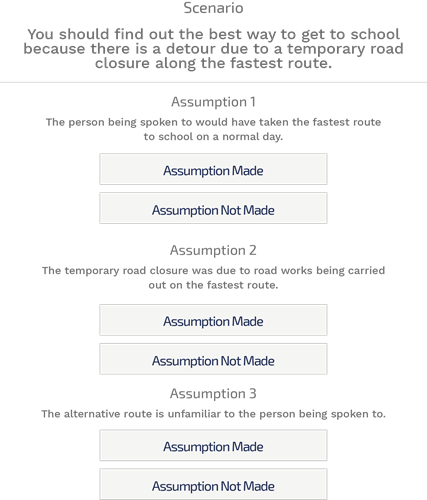
Inferences
Inference refers to a conclusion drawn from considered facts and observations. For example, if you hear loud voices at a distance, you may infer that someone is fighting or having a heated discussion. But the inference may or not be true. There is a possibility that the voices may belong to some a group of people, excited and just happy to live.
A candidate is given statements, which are followed by possible inferences that are to be marked as Definitely True (T), Probably True (PT), Insufficient Data (ID), Probably False (PF), and False (F).
Inferences sometimes are also based on common knowledge.
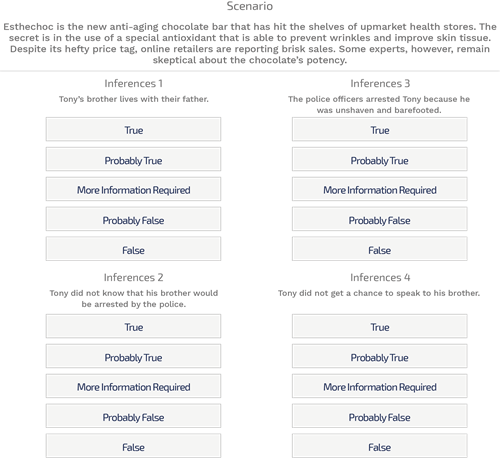
Deduction
For the purpose of the test, the deduction is a conclusion given for a statement, not derived from one’s own knowledge. The test lists a passage, and then state possible statements from the passage are listed. If the statement cannot be deduced from the passage, it is marked “No” and “Yes” for the statements that can be deduced.
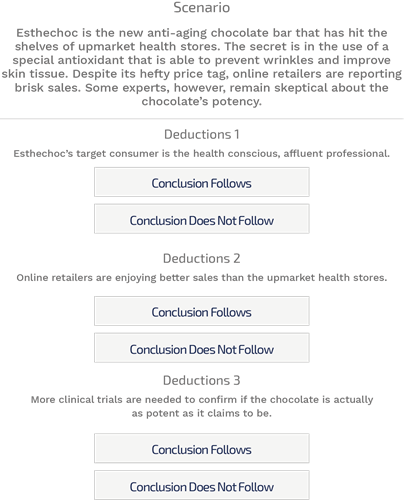
Interpretation
The interpretation refers to the conclusions that are drawn from the given passage, based solely on the information that is presented in the passage. For the purpose of the test, it is to be assumed that all the information listed is absolutely and certainly true. The conclusions are also to be judged independently.
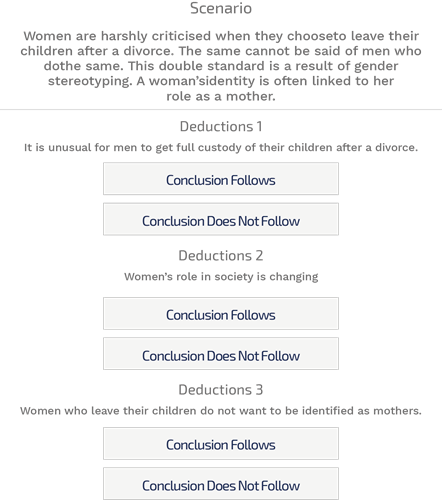
Evaluation of arguments
Evaluation of the argument refers to the selection of “Strong” and “Weak” argument status for a set of arguments, produced for a passage or a scenario. The candidates are to pass judgment based on the relevant information and sense of self.
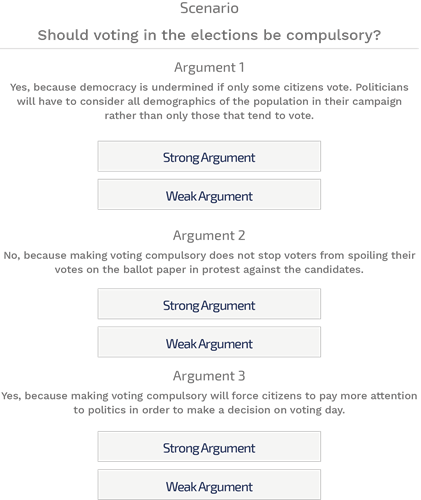
The yield of the Watson-Glaser Critical Thinking Test
Watson-Glaser test has a reputation because it can be used, to predict job success ratio. Due to the proficiency of W-GCTA to do so, it is widely used, for every employer wants to know how his employee will perceive, measure, analyze and react in a situation.
The test is a preferred testing method for law firms, which in principle require higher critical thinking to support their facts versus assumptions. The Watson –Glaser critical thinking test has also been to evaluate the cognitive abilities to select future leaders, managers and hiring the right person for the right job.
Does Watson-Glaser Critical Thinking Test work?
The Watson-Glaser Critical Thinking Test has a history of development spanned over 85 years, and the feedback from the clients suggests that the test is highly predictive, in terms of job success at the graduate level and above.
Watson-Glaser Predictive Validity Study 2011, shows a high correlation coefficient, which posits a strong link between barrister training success and the Watson-Glaser.
Watson-Glaser Predictive Validity Study, conducted in 2013, states that the top performers achieved the highest average score in the Watson-Glaser test, which strongly asserts that the test is highly predictive of task performance in a specific role. The study was spanned over two years, and the performance of 250 candidates was observed thoroughly.
How can Assessment-Training.com help you ace your Watson Glaser Critical Thinking Test?
Assessment-Training.com is your number 1 online practise aptitude test and assessment provider. We aim to help you ace your assessment by providing you with practise aptitude tests that mimic the tests used by employers and recruiters. Our test developers have years of experience in the field of occupational psychology and developed the most realistic and accurate practice tests available online. Our practise platform uses leading-edge technology and provides you feedback on your scores in form of test history, progress, and performance to your norm group.
Check out our tailor-made Watson-Glaser Critical Thinking Test to fully prepare you for your assessment.
The Assessment-Training.com data science team found that candidates increased their scoring accuracy through practice and went into their assessments more confident. Remember, you need to practice to make sure you familiarize yourself with the test formats, work on your accuracy, and experience performing under time pressure.
- 10 Tests
- 126 Questions
- One-off payment
- 10 Tests
- 126 Questions
- One-off payment
- 197 Tests
- 3146 Questions
- One-off payment
